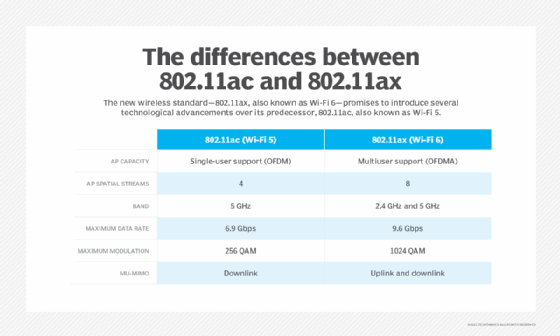Wi-Fi range extender (range expander)
What is a Wi-Fi range extender?
A Wi-Fi range extender is a network device used to increase the effective range of a wireless network. The range extender receives Wi-Fi signals from a Wi-Fi router, and then re-transmits the router's data to wireless endpoints that may have difficulty exchanging wireless data with the router directly.
That difficulty usually is due to interference or dead zones caused by physical objects, such as walls or a loss of Wi-Fi signal strength due to sheer distance, for example being in a remote part of a home or office.
The range extender also works in the opposite direction, receiving wireless data from wireless endpoints and then re-transmitting the endpoint's data back to the router.
Wi-Fi range extender vs. Wi-Fi repeater vs. Wi-Fi booster
The terms extender, booster and repeater are often used interchangeably in wireless network parlance, primarily because all three device types fundamentally perform the same job of bringing wireless capability to places where existing wireless services are poor or nonexistent. For the purposes of this discussion, the three terms can be used interchangeably. However, there are some technical differences among them for those seeking the most precision in terminology:
- Extender. A range extender typically uses an adapter to a wired connection between the router and extender, which in turn provides wireless coverage to the area where the extender is located. Some extender devices use powerline technology to establish the wired connection.
- Repeater. A repeater typically relies entirely on wireless connectivity to establish the link between the router and repeater. It fundamentally just re-transmits the signals at a stronger level to provide better-quality Wi-Fi network coverage to local Wi-Fi endpoints.
- Booster. Booster is a generic term that can be used to mean either an extender or a repeater. Consequently, booster can be the more confusing term.

From a physical standpoint, a range extender typically is a small device with several independently articulated antennas used to receive and transmit wireless signals. Although some range extenders can be situated on desks and shelves using wired AC adapters, many of the devices plug directly into a wall outlet, allowing the range extenders to be located inconspicuously within a building.
How does a Wi-Fi range extender work?
A Wi-Fi range extender is a collection of devices. At a minimum, there are two radios, each with separate receiving and transmitting antennas. It also includes the networking components needed to form a new wireless router. That new router is important because the wireless endpoint typically exchanges network communication with the range extender rather than the main wireless router. Thus, the range extender usually needs its own IP address and other network configuration information so that both the wireless router and the wireless endpoint can communicate with the extender.
The range extender is placed between the main wireless router and the desired wireless endpoint (or the area where wireless endpoints will be situated). If the range extender is too close to the main wireless router, the range extender will not offer real range benefit for remote wireless devices. Conversely, if the range extender is too far from the main wireless router, the extender itself may suffer reduced data throughput due to weak signals from the router.
Wi-Fi range extenders are generally easy to set up, and they can be configured to communicate with the main wireless router with little more than the click of a button on the extender. This establishes a logical connection between the main wireless router and the extender. At that point, a wireless endpoint can exchange data with the range extender as if the extender were the main wireless router.
It's important to note that the need to receive and re-transmit through the range extender will introduce some latency and reduce network performance experienced by remote wireless endpoints in comparison with wireless devices close to the router. This latency is generally minimal and is rarely noticeable for all but the most latency-sensitive applications.
As a more practical example, consider a baseball game where a ball caught in the outfield must be thrown to home plate. Rather than the outfielder throwing the ball directly to home plate, the outfielder instead throws the ball to an infielder, who then relays the ball to home plate. On a Wi-Fi network a similar relay is the job of the range extender.
How do you know if you need a Wi-Fi range extender?
Today's wireless routers serve as the principal hub of a local wireless network, and most can handle a multitude of wireless endpoints reliably. However, the key to wireless network operation is a traditional radio transmitter and receiver built into every wireless device. These radio components rely on low-power operation. This reduces power consumption for the host device and prevents radio signals from interfering with the signals of other similar devices. That allows multiple devices to be deployed without interference.
The decision to use a Wi-Fi range extender should then be based on need, which involves three main criteria:
- Where does the endpoint need to be? Wi-Fi is attractive because it eliminates the need for physical network wiring and allows Wi-Fi endpoints a level of data mobility within the Wi-Fi coverage area. Wi-Fi endpoints that regularly operate at the edge (or outside) of the main wireless router's coverage area may need a Wi-Fi range extender. However, range is not the sole factor in wireless network performance. Physical obstacles such as walls, doors and metal infrastructure can degrade Wi-Fi coverage.
- What is the Wi-Fi signal strength in the remote area? Wi-Fi devices have long used a unique icon consisting of a bottom point with three expanding semicircles above the point (reminiscent of a radar screen). The icon indicates the availability of Wi-Fi capability, as well as showing the network's relative signal strength by the number of semicircular lines, displayed in roughly 25% increments. If the signal strength of the remote Wi-Fi endpoint is 25% or less (one or no bars), a range extender may be needed.
- What connectivity does the application need? Not all applications need strong connections. Common productivity apps (such as Office 365) may need minimal network bandwidth, while other applications (such as multiplayer games) may impose high bandwidth and low latency requirements for a proper user experience, and those requirements may necessitate the use of a Wi-Fi range extender.
It's important to note that Wi-Fi range extenders are not intended to be "daisy-chained" (one extender is not supposed to talk to another extender, then another, and so on). It is possible to use multiple range extenders, but all of those extenders must talk to the main wireless router as the primary hub.
What to consider when choosing a Wi-Fi range extender
Today, there are many devices in the marketplace designed to improve wireless signal coverage. The key to success in selecting a Wi-Fi range extender is to consider three major factors:
- Similar Wi-Fi specifications. Review the Wi-Fi specifications for your wireless router and select a range extender that is consistent with those specifications. For example, some of the latest wireless devices employ the 802.11ax or Wi-Fi 6 standards. Most wireless devices today are designed to be backward-compatible (new specs automatically "fall back" to older specs), but be sure this is the case before purchasing a range extender.
- Multi-band operation. Select a range extender that is designed to operate across two radio bands simultaneously. This allows the extender to boost performance by using different bands for different purposes. Similarly, extenders with multiple antennas can allow the device to transmit and receive simultaneously, adding even better performance. For example, a range extender might have up to four antennas -- two to transmit on two different bands, and two to receive on those two different bands.
- Form factor. Consider where range extender and wireless devices will be placed in a home or office and select a form factor best suited to the deployment location and environment.

What are the different types of Wi-Fi extenders?
There are several different ways to connect a wireless range extender to a main wireless router, as well as several form factors to consider.
- Wireless range extender. The most common range extender is completely wireless (other than a connection to AC power). These devices both send and receive Wi-Fi signals entirely over the air.
- Powerline adapters. This approach to wireless range extension is something of a misnomer, using the AC electrical wires within the home or office to both supply power while also carrying network signals (which are modulated onto the physical AC power wiring). The main router must also connect a port on the router to a companion powerline adapter. Because powerline adapters do not require a wireless connection to the main router (the only wireless capability is from the adapter to the endpoint devices), they can be located farther away from the main router.
- Coaxial adapters. Similar to powerline adapters, coaxial (MoCA) adapters with Wi-Fi can use the coaxial cabling in a home or office to create wired connections to remote adapters which can then utilize wireless capability to provide Wi-Fi coverage, although some MoCA devices simply provide a wired ethernet LAN port. The main router is already connected to a coaxial port which connects to the internet service provider (ISP).
Also consider where the Wi-Fi range extender will be deployed:
- Desktop. A desktop form factor is a device package typically located on a desk or shelf and then powered with an AC adapter.
- Wall AC. A wall AC form factor is a device package that generally plugs directly into an AC outlet. This takes the device off desks and shelves and keeps it low and innocuous.
- Outside. Some devices are designed and sealed for harsher environments such as dusty, hot/cold or humid environments such as outdoor deployments.
How to set up a Wi-Fi range extender
The exact instructions for setting up a Wi-Fi range extender can vary depending on the manufacturer and device, but there are a few common steps to look for:
- Know the network name and service set identifier (SSID) of the current network.
- Connect the wireless range extender. This ensures that the extender is on the same LAN as the main router, along with endpoint devices such as a desktop PC or laptop.
- Use a web browser on the PC to open a webpage to the extender. This usually relies on a common IP address such as 192.168.1.1, but the device's instructions will give you the precise address or URL.
- A login for the extender will appear in the browser. Log into the extender using the name and password provided. Change these logon credentials as part of the device setup or soon after for security purposes.
- Use the extender's webpage to configure the range extender to use the desired wireless network name and SSID. This is basically the step that synchronizes the extender with the existing wireless router.
- Save any changes or new settings on the extender and close the extender's webpage. This should complete the extender setup.
- Now the extender can be powered down and physically redeployed in the most desirable location.
Learn the differences between Wi-Fi 6 vs. Wi-Fi 5 and a wireless access point vs. router.








